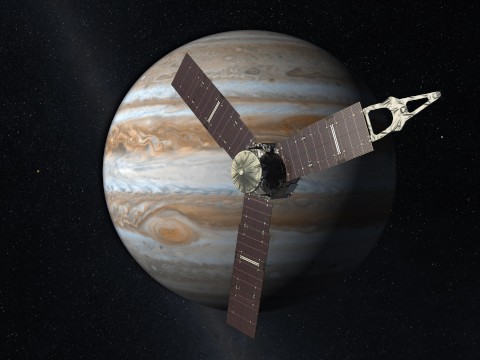Sound in Space?
What do we mean by "sound" in space?
Pressure waves like those in the atmosphere that we normally think of as sound do not propagate at audible frequencies in the extremely low density gases that fill space. However these low density gases, typically a few to a few hundred particles per cubic centimeter, are mostly charged, so the particles can interact at a distance via electric and magnetic fields. Mix in rotating planetary and solar magnetic fields, sources and sinks of particles, ionizing radiation and other sources of energy, and an orchestra of wave modes arise. Many of these plasma waves occur naturally at audible frequencies, although a human would not be able to hear them in space because the pressure is far too low. They are associated with moving particles, so, theoretically, an ultra-sensitive microphone might be able to record some plasma waves. In practice, the oscillating electric and magnetic field components are very easy to detect with antennas, so that is what we do. These waveforms can simply be played back as audio through a speaker without any modification.
In other cases, for example auroral kilometric radiation, radio waves which propagate above the frequencies of plasma waves (with no particles involved in their propagation) are recorded and played back more slowly, shifting their high frequencies down into the range of human hearing.
For a more formal introduction to waves in space plasmas, see the tutorial article by Dr. William Kurth.
For a very accessible introduction to space audio, see "What Space Sounds Like - ACOUSTICS" from The Point Studios on YouTube. (And while we're on the topic, note that there are a huge number of fake space sound videos on YouTube. Beware! The planets don't actually emit meditation music.)
Oh, and be sure to explore all of the examples below!
Featured Items
Start with these.
 Voyager 1 PWS first interstellar audio recordings
Voyager 1 PWS first interstellar audio recordingsOngoing observations of shock-associated waves
 Van Allen Probes EMFISIS Waves or
EMFISIS MAG audio samples
Van Allen Probes EMFISIS Waves or
EMFISIS MAG audio samplesAudio clips from the twin Van Allen Probes
 Juno Waves audio samples
Juno Waves audio samplesStarting with Juno crossing Jupiter's bow shock
Extended Samples
If sound bites aren't enough, try these longer selections.
 Voyager-1: Jupiter Encounter
Voyager-1: Jupiter EncounterThe complete day Voyager 1 spent at Jupiter
 Voyager-2: Arrival at Jupiter
Voyager-2: Arrival at JupiterThe clash of the solar wind with Jupiter's immense magnetosphere
Saturn encounter, November 12-13, 1980
The entire Saturn encounter from August 24 to September 7, 1981
Uranus flyby from January 23 to 29, 1986
Neptune flyby from August 23 to 25, 1989
Archives
Here's a collection of older features.
 Cassini Listens to Lightning at Saturn
Cassini Listens to Lightning at SaturnThe crackle and pop of lightning deep in the planet's atmosphere
 Cassini Observes Saturn Kilometric Radiation
Cassini Observes Saturn Kilometric RadiationThe eerie sounds and bizarre features of Saturn's radio emissions
 Voyager Termination Shock
Voyager Termination ShockPlasma wave sounds at the solar wind termination shock
 Cassini Encounters Saturn's Bow Shock
Cassini Encounters Saturn's Bow ShockWhere the solar wind collides with Saturn's magnetic field
 Radio Rotation of Saturn from Cassini RPWS Measurements
Radio Rotation of Saturn from Cassini RPWS MeasurementsThe puzzling change in Saturn's radio rotation period
 Sounds of Space and the Kronos Quartet "Sun Rings"
Sounds of Space and the Kronos Quartet "Sun Rings"The pre-performance presentation
 Terry Riley's "Sun Rings" performed by the Kronos Quartet
Terry Riley's "Sun Rings" performed by the Kronos QuartetThe musical production inspired by sounds of space
 Heliospheric Radio Emissions Detected by Voyager
Heliospheric Radio Emissions Detected by VoyagerAudio from the edge of the solar system
 Type III Radio Bursts from the Oct 28 and Nov 4, 2003, Solar Flares
Type III Radio Bursts from the Oct 28 and Nov 4, 2003, Solar FlaresThe signatures of record-setting solar eruptions
 Sounds of the Magnetosphere
Sounds of the MagnetosphereSounds collected by the Polar spacecraft
 Sounds of Space
Sounds of SpaceGeneral information
Related Links
These are our related research projects.
Social Media
More sources of space audio public outreach . . .













 The audio files found at this site are available
The audio files found at this site are available